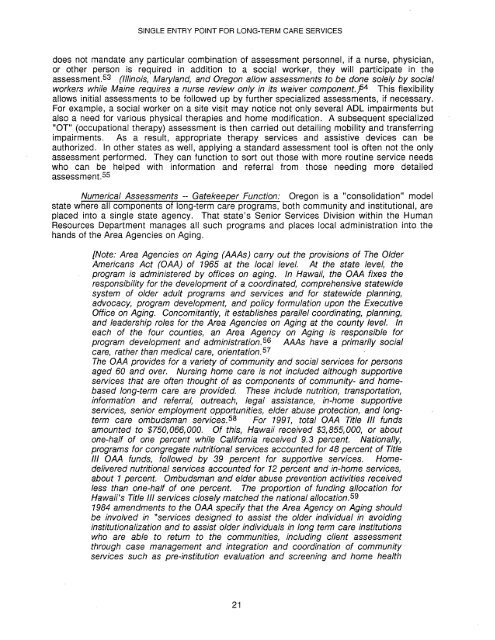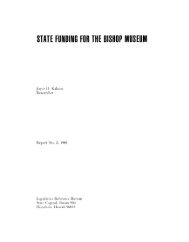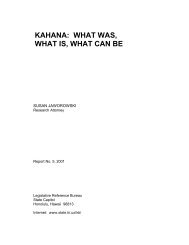long-term care - Legislative Reference Bureau
long-term care - Legislative Reference Bureau
long-term care - Legislative Reference Bureau
You also want an ePaper? Increase the reach of your titles
YUMPU automatically turns print PDFs into web optimized ePapers that Google loves.
SINGLE ENTRY POINT FOR LONG-TERM CARE SERVICES<br />
does not mandate any particular combination of assessment personnel, if a nurse, physician,<br />
or other person is required in addition to a social worker, they will participate in the<br />
assessment. 53 (l!Iinois, Maryland, and Oregon allow assessments to be done solely by social<br />
workers while Maine requires a nurse review only in its waiver component.j54 This flexibility<br />
allows initial assessments to be followed up by further specialized assessments, if necessary.<br />
For example, a social worker on a site visit may notice not only several ADL impairments but<br />
also a need for various physical therapies and home modification. A subsequent specialized<br />
"OT" (occupational therapy) assessment is then carried out detailing mobility and transferring<br />
impairments. As a result, appropriate therapy services and assistive devices can be<br />
authorized. In other states as well, applying a standard assessment tool is often not the only<br />
assessment performed. They can function to sort out those with more routine service needs<br />
who can be helped with information and referral from those needing more detailed<br />
assess me nt. 55<br />
Numerical Assessments -- Gatekeeper Function: Oregon is a "consolidation" model<br />
state where all components of <strong>long</strong>-<strong>term</strong> <strong>care</strong> programs, both community and institutional, are<br />
placed into a single state agency. That state's Senior Services Division within the Human<br />
Resources Department manages all such programs and places local administration into the<br />
hands of the Area Agencies on Aging.<br />
[Note: Area Agencies on Aging (AAAs) carry out the provisions of The Older<br />
Americans Act (OAA) of 1965 at the local level. At the state level, the<br />
program is administered by offices on aging. In Hawaii, the OAA fixes the<br />
responsibility for the development of a coordinated, comprehensive statewide<br />
system of older adult programs and services and for statewide planning,<br />
advocacy, program development, and policy formulation upon the Executive<br />
Office on Aging. Concomitantly, it establishes parallel coordinating, planning,<br />
and leadership roles for the Area Agencies on Aging at the county level. In<br />
each of the four counties, an Area Agency on Aging is responsible for<br />
program development and administration. 56 AAAs have a primarily social<br />
<strong>care</strong>, rather than medical <strong>care</strong>, orientation. 57<br />
The OAA provides for a variety of community and social services for persons<br />
aged 60 and over. Nursing home <strong>care</strong> is not included although supportive<br />
services that are often thought of as components of community- and homebased<br />
<strong>long</strong>-<strong>term</strong> <strong>care</strong> are provided. These include nutrition, transportation,<br />
information and referral, outreach, legal assistance, in-home supportive<br />
services, senior employment opportunities, elder abuse protection, and <strong>long</strong><strong>term</strong><br />
<strong>care</strong> ombudsman services. 58 For 1991, total OAA Title 11/ funds<br />
amounted to $750,066,000. Of this, Hawaii received $3,855,000, or about<br />
one-half of one percent while California received 9.3 percent. Nationally,<br />
programs for congregate nutritional services accounted for 48 percent of Title<br />
11/ OAA funds, followed by 39 percent for supportive services. Homedelivered<br />
nutritional services accounted for 12 percent and in-home services,<br />
about 1 percent. Ombudsman and elder abuse prevention activities received<br />
less than one-half of one percent. The proportion of funding allocation for<br />
Hawaii's Title 11/ services closely matched the national allocation. 59<br />
1984 amendments to the OAA specify that the Area Agency on Aging should<br />
be involved in "services designed to assist the older individual in avoiding<br />
institutionalization and to assist older individuals in <strong>long</strong> <strong>term</strong> <strong>care</strong> institutions<br />
who are able to return to the communities, including client assessment<br />
through case management and integration and coordination of community<br />
services such as pre-institution evaluation and screening and home health<br />
21
















